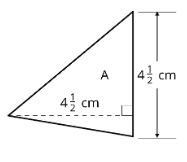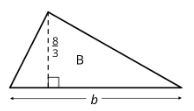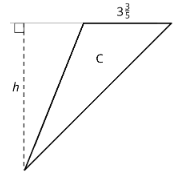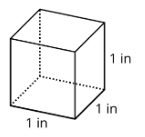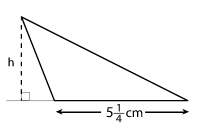Illustrative Mathematics Unit 6.4, Lesson 14: Fractional Lengths in Triangles and Prisms
Learning Targets:
- I can explain how to find the volume of a rectangular prism using cubes that have a unit fraction as their edge length.
- I can use division and multiplication to solve problems involving areas of triangles with fractional bases and heights.
- I know how to find the volume of a rectangular prism even when the edge lengths are not whole numbers.
Related Pages
Illustrative Math
Grade 6
Lesson 14: Fractional Lengths in Triangles and Prisms
Let’s explore area and volume when fractions are involved.
Illustrative Math Unit 6.4, Lesson 14 (printable worksheets)
Lesson 14 Summary
The following diagram shows how to use division and multiplication to solve find the volumes of rectangular prisms with fractional bases and heights.
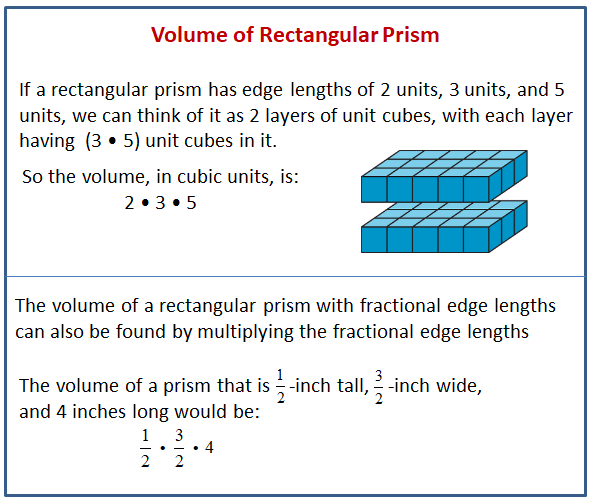
Lesson 14.1 Area of Triangle
Find the area of Triangle A in square centimeters. Show your reasoning.
Scroll down the page for the answer to the “Are you ready for more?” section.
Lesson 14.2 Bases and Heights of Triangles
- The area of Triangle B is 8 square units. Find the length of b. Show your reasoning.
- The area of Triangle C is 54/5 square units. What is the length of h? Show your reasoning.
Lesson 14.3 Volumes of Cubes and Prisms
Use the cubes or the applet for the following questions.
Show Applet
- Your teacher will give you a set of cubes with an edge length of ½ inch. Use them to help you answer the following questions.
a. Here is a drawing of a cube with an edge length of 1 inch. How many cubes with an edge length of ½ inch are needed to fill this cube? b. What is the volume, in cubic inches, of a cube with an edge length of ½ inch? Explain or show your reasoning.
c. Four cubes are piled in a single stack to make a prism. Each cube has an edge length of inch. Sketch the prism, and find its volume in cubic inches. - Use cubes with an edge length of ½ inch to build prisms with the lengths, widths, and heights shown in the table.
a. For each prism, record in the table how many ½-inch cubes can be packed into the prism and the volume of the prism.
| prism length (in) | prism width (in) | prism height (in) | number of ½-inch cubes in prism | volume of prism (cu in) |
| ½ | ½ | ½ | ||
| 1 | 1 | ½ | ||
| 2 | 1 | ½ | ||
| 2 | 2 | 1 | ||
| 4 | 2 | 3/2 | ||
| 5 | 4 | 2 | ||
| 5 | 4 | 2½ |
3. What is the volume of a rectangular prism that is 1½ inches by 2¼ inches by 4 inches? Show your reasoning.
Are you ready for more?
A unit fraction has a 1 in the numerator. These are unit fractions: 1/3, 1/100, 1/1. These are not unit fractions:2/9, 8/1, 2⅕.
- Find three unit fractions whose sum is ½. An example is: ⅛ + ⅛ + ¼ = ½ How many examples like this can you find?
- Find a box whose surface area in square units equals its volume in cubic units. How many like this can you find?
Lesson 14 Practice Problems
- Clare is using little wooden cubes with edge length ½ inch to build a larger cube that has edge length 4 inches. How many little cubes does she need? Explain your reasoning.
- The triangle has an area of 7 7/8 cm2 and a base of 5 1/4 cm.
What is the length of h? Explain your reasoning.
b. Check your answer by multiplying it by the given side length (3⅔). Is the resulting product 11? If not, revisit your work for the first question.
- a. Which of the following expressions can be used to find how many cubes with edge length of ⅓ unit fit in a prism that is 5 units by 5 units by 8 units? Explain or show your reasoning.
i. (5 · ⅓) · (5 · ⅓) · (8 · ⅓)
ii. 5 · 5 · 8
iii. (5 · 3) · (5 · 3) · (8 · 3)
iv. (5 · 5 · 8) · (⅓)
b. Mai says that we can also find the answer by multiplying the edge lengths of the prism and then multiplying the result by 27. Do you agree with her statement? Explain your reasoning. - A builder is building a fence with 6¼-inch-wide wooden boards, arranged side-by-side with no gaps. How many boards are needed to build a fence that is 150 inches long? Show your reasoning.
- Find the value of each expression. Show your reasoning and check your answer.
a. 2 1/7; ÷ 2/7
b. 17/20 ÷ 1/4 - A bucket contains 11⅔ gallons of water and is ⅚ full. How many gallons of water would be in a full bucket?
Write a multiplication and a division equation to represent the situation, and then find the answer. Show your reasoning. - There are 80 kids in a gym. 75% are wearing socks. How many are not wearing socks? If you get stuck, consider using a tape diagram showing sections that each represent 25% of the kids in the gym.
- a. Lin wants to save $75 for a trip to the city. If she has saved $37.50 so far, what percentage of her goal has she saved? What percentage remains?
b. Noah wants to save $60 so that he can purchase a concert ticket. If he has saved $45 so far, what percentage of his goal has he saved? What percentage remains?
The Open Up Resources math curriculum is free to download from the Open Up Resources website and is also available from Illustrative Mathematics.
Try the free Mathway calculator and
problem solver below to practice various math topics. Try the given examples, or type in your own
problem and check your answer with the step-by-step explanations.

We welcome your feedback, comments and questions about this site or page. Please submit your feedback or enquiries via our Feedback page.
